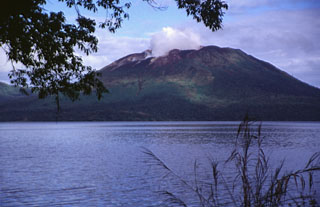Report on Gaua (Vanuatu) — 25 November-1 December 2009
Smithsonian Institution / US Geological Survey
Weekly Volcanic Activity Report, 25 November-1 December 2009
Managing Editor: Sally Sennert.
Please cite this report as:
Global Volcanism Program, 2009. Report on Gaua (Vanuatu) (Sennert, S, ed.). Weekly Volcanic Activity Report, 25 November-1 December 2009. Smithsonian Institution and US Geological Survey.
Gaua
Vanuatu
14.281°S, 167.514°E; summit elev. 729 m
All times are local (unless otherwise noted)
The Vanuatu Geohazards Observatory reported that a large explosion from Gaua's Mount Garat on 18 November was followed by high dense ash plumes. Seismicity increased on 25 October and remained significant through 24 November. According to news articles, an explosion that caused ashfall in inhabited areas on 26 November prompted the evacuation of more than 300 people. The Alert Level was raised to 4, the second highest level on a scale of 0-5.
Geological Summary. The roughly 20-km-diameter Gaua Island, also known as Santa Maria, consists of a basaltic-to-andesitic stratovolcano with an 6 x 9 km summit caldera. Small vents near the caldera rim fed Pleistocene lava flows that reached the coast on several sides of the island; littoral cones were formed where these lava flows reached the ocean. Quiet collapse that formed the roughly 700-m-deep caldera was followed by extensive ash eruptions. The active Mount Garet (or Garat) cone in the SW part of the caldera has three pit craters across the summit area. Construction of Garet and other small cinder cones has left a crescent-shaped lake. The onset of eruptive activity from a vent high on the SE flank in 1962 ended a long period of dormancy.
Sources: Agence France-Presse (AFP), Vanuatu Meteorology and Geohazards Department (VMGD)

